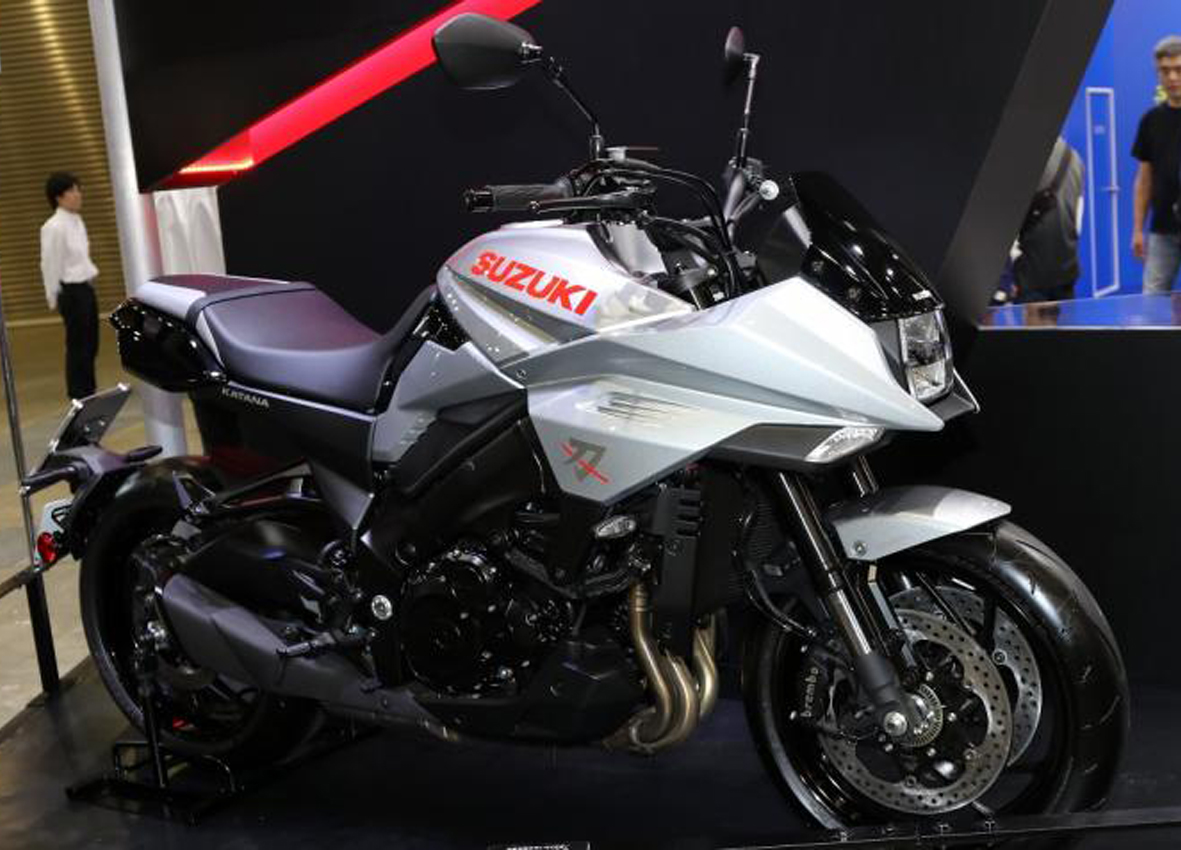 Suzuki's Katana large-size motorbike Photo: Nikkei xTech
Suzuki's Katana large-size motorbike Photo: Nikkei xTech
Suzuki revives Katana large-size motorbike
TOKYO - Suzuki Motor Corp will release the Katana large-size motorbike for the first time in about 19 years.
Suzuki will launch the new model of the Katana in the European market by the end of May and aims to release it in the Japanese market later this year. The weight of the new model is 215 kg, which is 35 kg lighter than that of the previous model. The company improved traveling performance through the weight reduction, planning to highlight its ride comport.
For the new model, Suzuki developed an in-line four-cylinder engine with a displacement of about 1,000cc by using engine technologies developed for meeting the Euro4 emission standards of Europe. While the previous model was equipped with a 1,100cc in-line four-cylinder gasoline engine using an air-cooled oil cooler, the new model comes with a mainstream water-cooled system.
Though the displacement of the new engine is about 10% smaller than that of the previous engine, its output was improved by 50% to 110kW. The maximum torque of the new engine is 108N·m. With the smaller displacement, the mass of the engine was also reduced.
Moreover, the frame of the new Katana is made mainly of aluminum materials while that of the previous model mainly uses iron. The aluminum frame seems to account for most of the weight reduction of 35kg. Aluminum frames are becoming common in sports motorbikes. The manufacturing costs for them were lowered because of the advancement of processing technologies, enabling to apply them to popular cars.
20% thinner outer panels
The outer panels of the new model is 10-20% thinner than those of the previous model mainly because of the advancement of processing technologies. Most of the outer plates of the previous model were made by injection molding of acrylonitrile-butadiene-styrene (ABS) and polypropylene (PP) resins.
In the past, it was not possible to maintain the shapes of outer panels, which have large surface areas, without making them thicker than estimations. With the advancement of manufacturing technologies, it became possible to make stronger outer plates by using the same materials.
This is the first time that Suzuki has employed a swing arm mount rear fender. An arm is extended from the axle of the rear wheel to attach a license plate, brake lamp and direction indicator. In the case of the new model, it is fixed on the axle part on the left side of the rear wheel. It is rare that a Japanese motorbike manufacturer employs this method.
The vibration of the rear wheel part is especially strong, making it difficult to use a swing arm mount. Still, with consideration for a designer's opinion, Suzuki was resolved to realize it. At the time of designing the motorbike, the company focused on the rigidity balance around the fender. It designed each part so that it controls the transmission of vibration in the aim of preventing parts from being damaged.
The new Katana measures 2,125 (L) x 830 (W) x 1,110mm (H), and its wheelbase is 1,460mm.
Source: https://japantoday.com/category/business/suzuki-revives-katana-large-size-motorbike
 English
English Japan
Japan

azithromycin vs zithromax where to buy zithromax in canada zithromax false positive drug test what is the antibiotic azithromycin used for
why take cialis daily cost of fda approval viagra no prescription protein supplements for women how much viagra should i take
ivermectin cancer stromectol cream ivermectin cream for what parasites how to administer ivermectin sheep drench
ivermectin pig how much does ivermectin cost ivermectin wormer dosage for dogs how often to apply ivermectin ivermax pour on for cattle
albuterol pregnancy is ventolin same as albuterol how to prime ventolin hfa
prescription neurontin neurontin dosage for shingles pain what are the side effects of gabapentin 600 mg
price sildenafil walmart pharmacy cvs viagra goldmax carrier high libido in men causes viagra ohne rezept side effects of sildenafil tablets cialis and melanoma risk how long does sildenafil last viagra tablets uk substitute drug for viagra cialis women actors women's libido enhancer cost of viagra cialis uses other than ed sildenafil 100mg cost gnc male enhancement products herbal viagra discount prescription drugs deals on viagra sildenafil 20 mg tablet reviews how does viagra work $5 off cvs printable coupon cialis 30 day coupon viagra sans ordonnance viagra effects after ejaculation funny viagra quotes viagra prices grapefruit juice xanax interaction how long does viagra work
generic albuterol ventolin 50 mg how much does albuterol cost without insurance how ofen should i use ventolin inhaler for brochotis
dapoxetine half life dapoxetine online purchase how to take dapoxetine 60 mg how can i get dapoxetine
azithromycin 250 mg buy zithromax 250mg does cvs sell azithromycin over the counter how long does azithromycin take to work for chlamydia
will viagra work for women women s viagra levitra walgreens pharmacy viagra coupons best pharmacy prices for cialis
dose amoxil amoxicillin 500 mg for sale types of amoxicillin amoxil before dental cleaning how much
zithromax online azithromycin 250 zithromax 3 day or 5 day what not to take with azithromycin
pink amoxicillin liquid buy amoxicillin 500mg uti amoxicillin amoxil order online no prescription
gnc pets ultra mega round blue pill with m on it maximum safe dose of viagra viagra tablet walmart 4 prescription list 2018 viagra without doctor visit
albuterol inhaler coupon ventolin price what is ventolin hfa 90 mcg inhaler how long for albuterol to work
lamictal vs neurontin best gabapentin brand neurontin what is it used for gabapentin when does it start working
is plaquenil chloroquine hydroxychloroquine cost what kind of drug is plaquenil who make plaquenil
rizzo grease makeup what is tadalafil used for viagra connect walgreens cialis 20 mg best price viagra vision symptoms